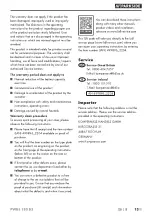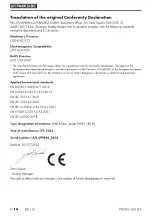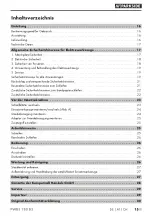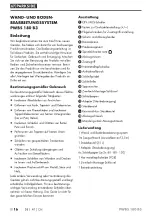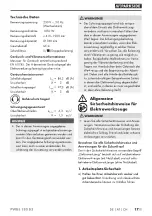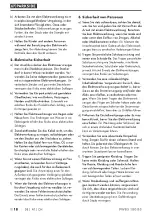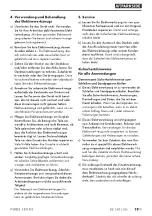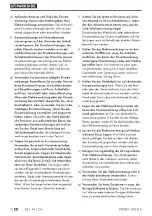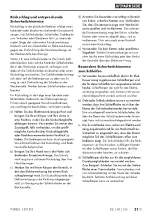
PWBS 180 B3
■
6
│
GB
│
IE
h)
Wear personal protective equipment.
Depending on the application, ensure that
you use full face protection, eye protection or
goggles. As required, use a dust mask,
hearing protection, protective gloves or special
apron that protect you from grindings and
material particles.
Protect your eyes from flying
debris that may be created during certain
applications. Dust or filter masks must be used
to filter any dust created by the application.
Long-term exposure to loud noise can cause
a hearing loss.
i)
Ensure that other people remain at a safe
distance from your workspace. Anyone who
enters the workspace must wear personal
protective equipment.
Fragments of the workpiece or broken acces-
sory tools can fly off and cause injury – even
outside the immediate working area.
j)
Hold the power tool only by the insulated
handles when you are carrying out work in
which the accessory tool may come into
contact with concealed power cables or the
tool’s own power cord.
Contact with a live
wire may make exposed metal parts of the
power tool live and could give the operator an
electric shock.
k)
Keep the power cord away from any rotating
accessories.
If you lose control of the appli-
ance, the cord may get caught or cut and your
hand or arm could get caught in the rotating
accessory tool.
l)
Never put the power tool down until the
accessory tool being used has come to a
complete standstill.
The rotating accessory tool
can come into contact with the surface and
cause you to lose control of the power tool.
m)
Do not leave the power tool running whilst
carrying it.
Accidental contact of your clothing
with the rotating attachment part could lead to
an injury.
n)
Clean the ventilation slits of your power tool
regularly.
The engine fan draws dust into the
housing and a strong accumulation of metal
dust can cause electrical hazards.
o)
Never use the power tool in the vicinity of
inflammable materials.
Sparks can ignite such
materials.
p)
Do not use any accessory tools which require
liquid coolant.
The use of water or other liquid
coolants may lead to an electric shock.
Kickback and corresponding
safety instructions
Kickback is a sudden reaction caused when a
rotating accessory tool, e.g. sanding disc, sanding
plate, wire brush, etc., catches or jams. Catching or
jamming leads to an abrupt stop of the rotating
accessory tool. If this happens, an uncontrolled
power tool turns rapidly against the direction of
rotation of the accessory tool caught in the
blockage.
If, for example, a sanding disc catches or jams in a
workpiece, the edge of the sanding disc projecting
into the workpiece can get caught and break off
the sanding disc or cause a kickback. The sanding
disc can then fly in the direction of the operator or
away from him, depending on the direction of
rotation of the disc at the blockage. This can also
break sanding discs.
A kickback is caused by improper or incorrect use
of the power tool. This can be avoided by taking
proper precautions as given below.
a)
Hold the power tool firmly in both hands and
position your body and arms so they can
absorb the force of a kickback. Always use
the additional handle, if available, so that
you have the maximum possible control over
the kickback force or reaction forces at full
speed.
By taking adequate precautions, the
operator can stay in control of the kickback
and reaction forces.
b)
Never hold your hand close to a rotating
accessory tool.
The accessory tool could
jump out of your hand if there is a kickback.
c)
Avoid having any part of your body in the
region in which the power tool is likely to
move in event of a kickback.
The kickback will
force the electrical tool in the opposite direction
to the direction of rotation of the sanding disc at
the blockage.
Summary of Contents for 499896 2204
Page 3: ......
Page 4: ...A B 19a 18a...
Page 52: ...PWBS 180 B3 48 FR BE...
Page 68: ...PWBS 180 B3 64 NL BE...
Page 98: ...PWBS 180 B3 94 PL...
Page 114: ...PWBS 180 B3 110 SK...
Page 160: ...PWBS 180 B3 156 IT...
Page 176: ...PWBS 180 B3 172 HU...
Page 220: ...PWBS 180 B3 216 RO...
Page 222: ...PWBS 180 B3 218 BG PWBS 180 B3 18a 19a 1 1 m 3 5 m 1 25 L 1 6 2 40 80 120 1 YG8 1 1...
Page 224: ...PWBS 180 B3 220 BG 2 a 3 a...
Page 225: ...PWBS 180 B3 BG 221 4 a 5 a a...
Page 226: ...PWBS 180 B3 222 BG...
Page 227: ...PWBS 180 B3 BG 223 a a...
Page 228: ...PWBS 180 B3 224 BG a...
Page 229: ...PWBS 180 B3 BG 225 FFP 2...
Page 230: ...PWBS 180 B3 226 BG A 12 3 2 mm...
Page 231: ...PWBS 180 B3 BG 227 P2 19a 18a 19a 18a...
Page 232: ...PWBS 180 B3 228 BG...
Page 233: ...PWBS 180 B3 BG 229 2012 19 EU...
Page 234: ...PWBS 180 B3 230 BG a b 1 7 20 22 80 98 3 II 3...
Page 238: ...PWBS 180 B3 234 GR PWBS 180 B3 ON OFF 18a 19a 1 1m 3 5 m 1 25 1 6x 2x 40 80 120 1 YG8 1 1...
Page 240: ...PWBS 180 B3 236 GR 2 3...
Page 241: ...PWBS 180 B3 GR 237 4 5...
Page 242: ...PWBS 180 B3 238 GR...
Page 243: ...PWBS 180 B3 GR 239...
Page 244: ...PWBS 180 B3 240 GR ON OFF Off...
Page 245: ...PWBS 180 B3 GR 241 FFP2...
Page 246: ...PWBS 180 B3 242 GR A 12 3 2 mm P2 19a 18a 19a 18a...
Page 247: ...PWBS 180 B3 GR 243...
Page 248: ...PWBS 180 B3 244 GR ON OFF ON OFF On Off On Off...
Page 249: ...PWBS 180 B3 GR 245 2012 19 U a b 1 7 20 22 80 98...
Page 250: ...PWBS 180 B3 246 GR Kompernass Handels GmbH 3 2251 1994...

















